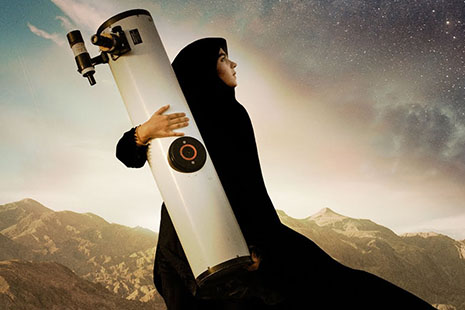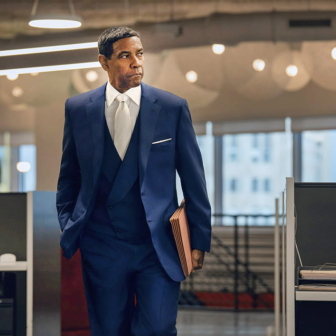When T.S. Eliot wrote that “Human kind/Cannot bear very much reality,” he hadn’t seen the thousands packing in to the Sydney Film Festival’s huge and remarkable spread of documentary. “Reality” – in the sense of truth pursued on locations and in editing suites, assemblages of fact linked and netted by interpretation – seemed to be exactly what they were after, no matter where. It has been said that a film festival is a lot of virtual travel; some of that travel takes in places where, outside of a film festival, we’d never really want to go.
After The Fog of War and The Thin Blue Line, no one concerned with twentieth-century history would stay away from the next Errol Morris essay. Faced with the operations of the military-industrial complex, the splits in the conscience of the powerful, the illogic of the deeply self-deceived, Morris is the ultimate cunning, soft-spoken strategist; he has described himself as a director-detective, rather than producer-director – once, between films, he spent time as a private eye. The Unknown Known, this year’s examination of Donald Rumsfeld and his obsession with memoranda, isn’t as deeply searching a film as The Fog of War, but that has to do with the level of interest one can feel in the particular human subjects. Robert McNamara, with his many chapters of involvement back to the second world war, was worth more of our time and Errol Morris’s subtle interview-management than is Rumsfeld. That said, The Unknown Known must still count as one of the 2014 Sydney Film Festival’s most telling documentaries, exposing some of the internal workings of US imperialism under the G.W. Bush administration. Rumsfeld is on screen for most of the time; in consequence one emerges with a wry sense of grim knowledge gained, at the cost of spending more than an hour-and-a-half in the company of an accomplished professional liar.
The late and great critic Roger Ebert (1942–2013) praised Errol Morris for being “much more interested in the spaces between the facts than with the facts themselves” – that is, interested in the speaking positions assumed by those interviewed, in the ways in which “facts” do or don’t become evidence. Ebert himself never tired, not only of viewing films and writing about them for the Chicago Sun-Times, but also of ferreting around their pre-histories, and the conditions of production and reception. Another of the festival’s best documentaries is about him; this is Life Itself, directed by Steve James from material shot in the last five months of the critic’s life, with old photographs, video footage of the late-life wedding, and images from the TV program in which Ebert argued about movies in dialogue with his perennial rival, Gene Siskel of the Chicago Tribune. The film gives us old and new journalism, as Ebert dives into Facebook and Twitter. En route, it’s full of the life of the city and its newspapers; there are moments which echo the early chapters in Citizen Kane, and reminders of Page One, Andrew Rossi’s superb essay on the way the New York Times and its personnel face the digital age: is the Grey Lady on death row? Roger Ebert is; with body, head and face malformed by terminal cancer, he goes on tapping on his laptop in hospital, and continuing, miraculously, to get some fun out of everything.
So many documentaries have to do with survival. For Keep On Keepin’ On, two Australian film makers, Alan Hicks and Adam Hart, went to the United States to make their vibrant essay on the life and work of the trumpeter Clark Terry, who taught Miles Davis and Quincy Jones among others, and who, late in his life – and still blowing his horn brilliantly – became a mentor for a young blind pianist, Justin Kauflin. Terry, Kauflin and Terry’s wife Gwen are their own extraordinary stories, with Quincy Jones’s masterly narration weaving through them, and signalling outward; Jones’s own story is something else again, connecting to those of every other jazz master you’ve ever heard or heard of. Terry’s music, which some called “the happiest sound in jazz,” remains with us in the film even after he, at past ninety and ill, can’t help to produce it any longer; Kauflin’s piano goes on.
It was accidental illumination that this film was seen in short order after the curious, perversely comic The Kidnapping of Michel Houellebecq. This writer’s books, which I haven’t read, are notorious for his special forms of misanthropy and misogyny. Those elements in his disposition are convincingly enacted, by the man himself, in this demi-fictional replay of the days when, on the point of literary appearances, he disappeared from public sight; with him, the supposed kidnappers (played by Luc Schwarz, Mathieu Nicourt and others) engage in meandering, demi-philosophic dialogue while waiting for ransom to be organised. There’s a sour kind of comedy happening in the fogs of smoke and drink; the jokes are all at the writer’s expense, miserably self-absorbed as he is; he defines and personifies a mentality. Moving from this to Keep On Keepin’ On, you understand all over again that jazz evolved precisely to ride over and out from all that, from its beginnings in an underdog culture that refused exactly that mentality – grudging, self-pitying, hopeless – and refused it absolutely.
Some of the most popular documentaries are likely to reach the cinema circuits; those include Particle Fever, on the Large Hadron Collider at CERN (European Centre for Nuclear Research) on the Franco-Swiss border. This huge and expensive installation is there, in part, to work out what happened at the beginning of the universe. Curiosity drives crowds, even if your family doesn’t include an aspiring nuclear physicist; both screenings were packed out. Of this thrilling tale, more to come. Its distributor, Madman Entertainment, also has the wonderful Sepideh: Reaching for the Stars, and this also is one to wait for. The fourteen-year-old Sepideh passionately wants to be an astronomer, and if possible an astronaut as well; she is philosophically akin to the Saudi-Arabian Haifaa Al-Mansour’s Wadjda, first met at last year’s festival and then at local cinemas. It will be remembered that the intrepid Wadjda, aged ten, wanted to acquire a bicycle and ride it, against all the rules for girls; and also that as a considerable strategist, she won the money in a competition for recitation from the Koran.
Wadjda was a fictional creation, the kind where fiction is necessary precisely because it’s all true. Sepideh, directed by Berit Madsen, is documentary, and like many films from the Middle East, it was enabled as a co-production, with input from four European sources as well as from Iran. We find the girl toiling up a hillside at night, trailing her hijab and carrying her portable telescope. The uphill track is unforced symbolism; Sepideh’s widowed mother is struggling, and can’t but calculate that the best course is a well-arranged marriage for the girl. In countries where honour killings, forced marriages and domestic imprisonment persist – and those include Australia – the circulation of such films must be taken beyond middle-class urban audiences. Their excellence as cinema, both drama and document, isn’t an end in itself.
The major features on the program will resurface, among them Richard Linklater’s remarkable drama-documentary Boyhood, an essay on normally dysfunctional family life observed over twelve years in a sunny Texan suburb, a benign, modern Sons and Lovers. This was in the running for the Sydney Film Prize; the one that got it, the Dardenne brothers’ Two Days, One Night, will also reappear. In the meantime, cinephiles aware of Belgian cinema might profitably spend time with Philip Mosley’s excellent new book on Luc and Jean-Pierre Dardenne and their now-considerable oeuvre, from the documentary videos of the 1970s through the distinguished fictions of the past twenty-five years: The Cinema of the Dardenne Brothers: Responsible Realism (Wallflower Press, the Director’s Cut series, 2013). Their story should ring bells for Australians; they took a clear decision, early on, that they weren’t migrating to Paris, but in the teeth of provincial struggle they were going to make movies right there where they were; not even Brussels or near it, but in the province of Wallonia.
With all the productive interaction between festival and film trade, there are still films which, without the festival, would be very unlikely to reach us. It’s because of the Sydney festival’s current size and prosperity that, at the last crowded minute, it could draw in unprogrammed items hot from Cannes, those including the winner of the Palme d’Or, Nuri Bilge Ceylan’s Winter Sleep.
I can report that this film held a large audience mesmerised for all of its 196 minutes; and as with Ceylan’s Once Upon a Time in Anatolia, the magnetism has only so much to do with plot; these are tantalising fragments of drama, appearing and disappearing, trailing on into minds and memories beyond the limits of the screen. In this film the enchantment has to do with landscape, the Anatolian steppes, snowbound as we see them here, with the houses cut into the rocks; with the presence of an angry child, whose parents can’t afford the rent; and with the work of a formidable actor, Haluk Bilginer. His character, Aydin, is a former actor and in the present of the film, both a landlord and a columnist for a newspaper called The Voice of the Steppe. Seeing the alienation of Aydin’s beautiful younger wife, we seem at first to be in a world like that of Satyajit Ray’s Charulata (also seen in the festival’s retrospective programs). But the unhappiness of women – Nihal (Melisa Sözen), and Aydin’s divorced sister Necla (Demet Akbağ) – is an intractable, persistent element. Nihal understands herself: she needs meaningful work, as unequivocally as the wild horse, brutally captured, needs its freedom. This winter country isn’t so far from Chekhov’s, and Istanbul, like Chekhov’s Moscow, is always there, somewhere across an uncrossable distance.
Sometimes there appears a small film which strikes the viewer as being formally perfect. That is the case with Ida, discussed here in the last posting; it is the case with Abderrahmane Sissako’s Timbuktu, which, like Winter Sleep, came in late to the festival via Cannes. Sissako, who is spoken of as present-day Africa’s great director, takes up the jihadist assault on northern Mali with drive and clarity. A young deer is seen running over the sandhills; a family is assembled peacefully in their tent; a boy herds cattle in a river, and angers a fisherman casting his nets. It will not be possible for the end-credits to claim that “no animal was harmed…”; the visible death of a very important beast prefigures needless human murder. The jihadist vigilantes want women to be both hooded and gloved, even as they’re cleaning fish in the market. At the end, we understand more about the fleeing animal.
I will give some further comment soon on this super-abundant film festival. Its major Australian offering, David Michôd’s The Rover, is already on the circuits. •





